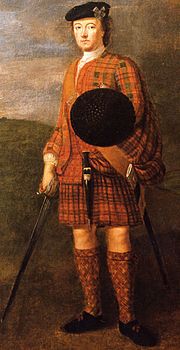George Murray (general) facts for kids
Quick facts for kids
Lord George Murray
|
|
|---|---|

Lord George Murray
|
|
| Born | 4 October 1694 Huntingtower, Perth, Scotland |
| Died | 11 October 1760 (aged 66) Medemblik, the Netherlands |
| Buried |
Bonifaciuskerk, Medemblik
|
| Allegiance | |
| Years of service | 1711–1715 (British Army) 1715–1719 (Jacobite) 1745–1746 (Jacobite) |
| Rank | Lieutenant (British Army) Lieutenant General (Jacobite) |
| Battles/wars | |
| Relations | John Murray, 1st Duke of Atholl (father) John Murray, 3rd Duke of Atholl (son) |
Lord George Murray (born October 4, 1694 – died October 11, 1760) was a Scottish nobleman and soldier. He was the sixth son of John Murray, 1st Duke of Atholl. Lord George Murray played a big role in the Jacobite rebellions, especially the one in 1745. The Jacobites wanted to bring the Stuart family back to the throne of Great Britain.
After being pardoned in 1725, he went back to Scotland and got married. In 1739, he even swore loyalty to King George II. However, when the 1745 Jacobite Rising began, Murray joined the Jacobite army. He became one of their main commanders and helped them achieve early successes, like their march to Derby and safe return.
But Lord George Murray also believed in the Union of 1707, which joined Scotland and England. This made him different from most Scottish Jacobites. Also, because he had worked with the government before, some people in the Jacobite army didn't fully trust him. These issues, along with his strong opinions, sometimes made it harder for him to lead effectively.
After the final defeat at the Battle of Culloden in April 1746, Murray had to leave Scotland and live in other European countries. He was not included in a special pardon given in 1747. He died in the Dutch town of Medemblik in 1760. His oldest son, John, later became the 3rd Duke of Atholl.
Contents
Early Life and Family
Lord George Murray was born on October 4, 1694, at Huntingtower Castle near Perth. His father was John Murray, Duke of Atholl, and his mother was Katherine Hamilton. Since he was a younger son, "Lord" was a courtesy title, meaning it was a title of respect, not a ruling title.
In June 1728, he married Amelia. They had three sons and two daughters who grew up. His son, John, later became the 3rd Duke of Atholl. Another son, James, became a Major-General in the British army. His son George became an admiral in the Royal Navy.
Military Career and Rebellions
Murray started studying at Glasgow University in 1711. But he soon left to join the British army in Flanders, becoming a lieutenant in March 1712. This was near the end of the War of the Spanish Succession, so he likely didn't see much fighting.
In 1714, Queen Anne died, and George I became king. This led to some important people joining the Jacobite cause. In September 1715, a rebellion started in Scotland.
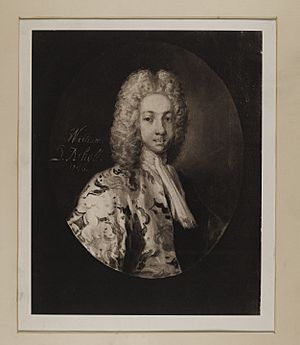
Lord George Murray joined the Jacobite army, even though his father tried to stop him. The rebellion didn't get enough support and soon failed. Murray and his brothers had to flee to France.
In 1719, the Murrays were involved in another rebellion. This one involved a planned Spanish landing in England. Lord George and his brother arrived in Scotland with some Spanish soldiers. However, the rebellion ended after a defeat at the Battle of Glenshiel on June 10. Murray was hurt but managed to escape. After this, it seemed unlikely the Stuarts would ever return to the throne.
Murray's life for the next few years isn't well known. He returned to Scotland in 1724 to see his dying father. The next year, he received a pardon, meaning he was forgiven for his past actions. He got married and seemed to stop supporting the Stuart cause. He even sent his oldest son to Eton College in England for school. In 1739, he swore an oath of loyalty to King George II.
The 1745 Jacobite Rising
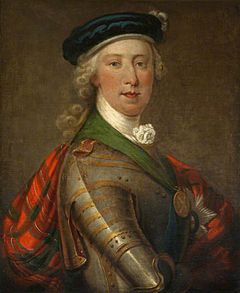
When Charles Edward Stuart (also known as Bonnie Prince Charlie) landed in Scotland in July 1745, Lord George Murray was working for the government. He was an advisor to the government's commander, Sir John Cope. But to everyone's surprise, Murray joined the Jacobites when they reached Perth on September 3. He wrote a letter to his brother, explaining why he felt he had to join the rebellion.
Murray said he joined because he felt the government was unfair and that wars were being fought for the wrong reasons. He believed a "Revolution" was needed to protect people's freedoms. However, because he had accepted a pardon and sworn loyalty to King George II before, some people didn't trust his reasons. Many Jacobites were also suspicious of him.
Murray's knowledge of Highland military ways was helpful. But his appointment also caused problems with the French and Irish officers who were with Charles. The most important of these was John O'Sullivan, who was Charles's chief of staff.

There were many reasons for the disagreements among the Jacobite leaders. One reason was that Scottish Jacobites often felt that the exiles (like O'Sullivan) were not risking as much as they were. The Scots faced being executed as rebels, while the exiles, who held French army ranks, would be treated as prisoners of war. Another reason was that Murray openly thought Charles was a "reckless adventurer."
Murray believed O'Sullivan's ideas for training the Highland soldiers were not realistic. He thought the Highlanders wouldn't follow formal drills or written orders. The exiles, however, thought Murray's ideas were old-fashioned. Both sides had some good points. Some Scots had served in European armies, and a new Scottish battalion formed in Perth fought well. But many Highland recruits were farmers who couldn't read or write, and their traditional fighting methods were changing.
One officer noted that Murray was good at planning big strategies but not always good at carrying them out. Another said that while Murray was talented, he had a quick temper and didn't like taking advice. For example, before the Battle of Prestonpans, he had a big argument with Charles. Murray's idea to attack the enemy's side, rather than head-on, turned out to be correct, but it upset Charles.
Overall, Murray's ideas were often good, even if not always perfect, but he didn't present them well. Many people shared his opinion of Charles. Most Scots who didn't want to invade England thought it would be better to focus on breaking the Union with England. Since Murray wanted to keep the Union, his goals were unclear. Also, he suggested removing Catholics from leadership positions, which made sense for public opinion, but was difficult since Charles and many of his advisors were Catholic.
Despite their doubts, the Scots agreed to invade England. Charles had told them he had promises of support from both England and France, but this turned out to be untrue. The army was small, and they needed to act quickly because they were running out of money and food.
Murray chose a route through North-West England, an area that had supported the Jacobites in 1715. They captured Carlisle on November 14. Murray then briefly resigned his command. This was partly because Charles refused to rotate the troops besieging the castle. But it was also because Murray didn't want to serve under the Duke of Perth, who was a Catholic and less experienced.
The Duke of Perth kindly stepped down, and Murray was put back in command. But this made his relationship with Charles even worse. Their relationship was completely broken when the decision was made to retreat from Derby on December 5. Charles blamed Murray for this decision for the rest of his life. However, many Scots had wanted to turn back earlier. It was also a huge blow when Charles admitted he had lied about the promised support.
The retreat was handled very well. Murray led a successful fight against government soldiers at Clifton Moor on December 18. Even though the invasion didn't achieve its main goal, reaching Derby and returning safely was a great military achievement.
With new recruits and some French soldiers, the Jacobites then tried to capture Stirling Castle. They defeated a relief force at the Battle of Falkirk Muir on January 17. But they soon gave up the siege and moved to Inverness.
Traditional Highland warfare often stopped in winter. After Falkirk, many clansmen left to go home, taking their loot with them. Murray's own Atholl Brigade was especially affected. He urged his brother to make examples of those who left, saying, "For God's sake make examples, or we shall be undone." Most people agreed with the decision to retreat, but Murray later said, "I was mostly blamed for it."
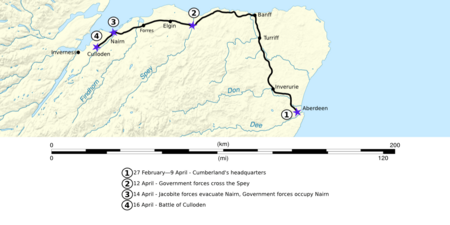
Murray led some raids from March 14 to 17, trying to show that guerrilla warfare (small, surprise attacks) was a better strategy. These raids were partly successful, but he couldn't capture his family home, Blair Castle. By spring, the Jacobites were low on money, food, and weapons.
When Cumberland (the government commander) moved north from Aberdeen on April 8, the Jacobite leaders decided to fight a battle. The location of the Battle of Culloden on April 16 is still debated. The Jacobites were tired from a failed night march, which Murray had suggested to surprise Cumberland's army. Many of their soldiers missed the battle, which ended in a huge government victory.
After the battle, about 1,500 survivors gathered. But on April 20, Charles told them to scatter and wait for him to return with more help. He left for France in September and never came back to Scotland. Murray escaped to the Dutch Republic in December 1746.
Later Life and Legacy
In March 1747, Murray went to Rome to meet with James (Charles's father), who gave him a pension. Charles wanted his father to imprison Murray, and the two never met again. However, Murray kept writing to Charles and his secretary, saying he was still loyal. His wife, Amelia, joined him in exile. They eventually settled in Medemblik, where Murray died on October 11, 1760. Even though his father had lost his title, Murray's son was allowed to become the Duke of Atholl in 1764.
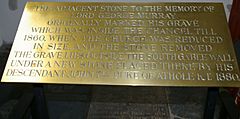
Unlike many others, Murray said his main reason for fighting was not Scottish nationalism. He wanted "the prestige of Great Britain to be upheld among the nations of the world." This suggests he disliked the Hanoverian kings because they were foreign. Interestingly, Charles was also foreign, having grown up in Italy and speaking French as his first language.
Historians have often focused on Murray's role in the Jacobite defeat, perhaps giving him too much blame. Historian Murray Pittock described him as "a brave, petulant, and gifted — though conservative — field commander."
Images for kids
-
Battle of Glenshiel, June 1719; Murray was wounded but escaped


